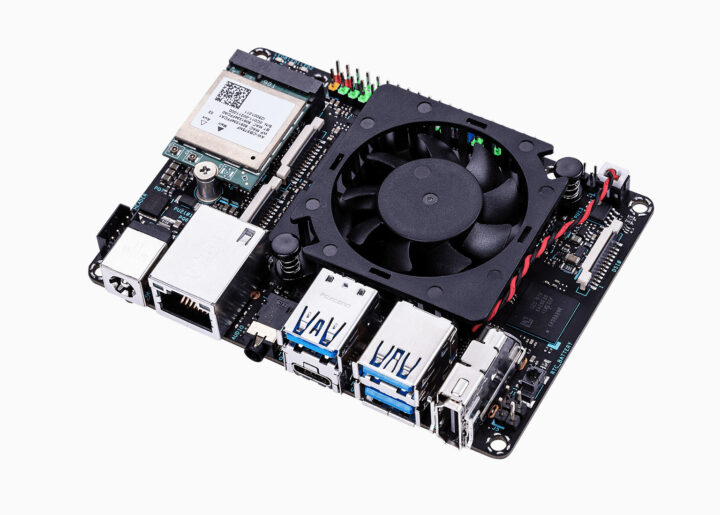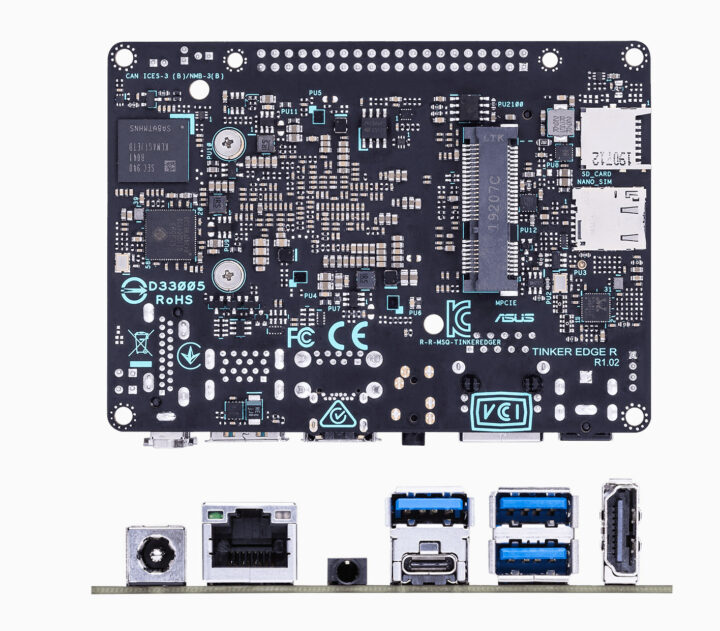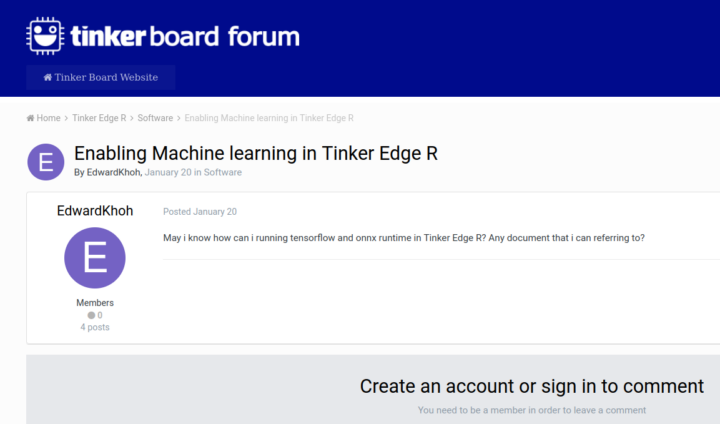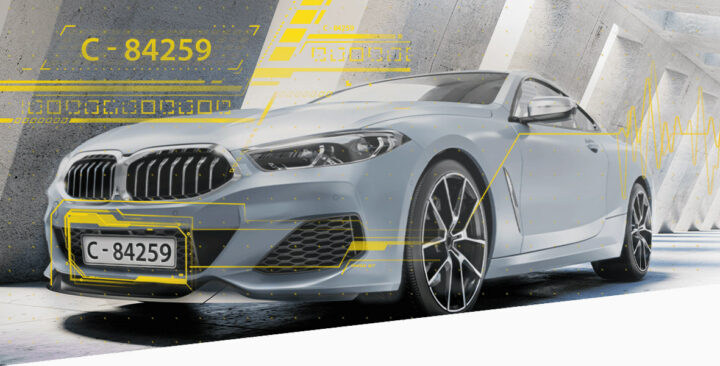ASUS Tinker Edge R Pico-ITX single board computer with Rockchip RK3399Pro AI processor was first unveiled in 2019 with 6GB RAM, but a cheaper 3GB RAM version with 2GB RAM for the CPU, and 1GB RAM with the integrated NPU just showed up in my news feeds.
Whether it comes with 3GB or 6GB RAM, the Tinker Edge R board should mostly be interesting for AI accelerated workload thanks to the 3 TOPS built-in NPU, as well as the two MIPI CSI camera interfaces.
ASUS Tinker Edge R (3GB) SBC specifications:
- SoC – Rochchip RK3399Pro hexa-core big.LITTLE processor with 2x Cortex A72 cores up to 1.8 GHz, 4x Cortex A53 cores @ 1.4 GHz, an Arm Mali-T860 MP4 GPU up to 800 MHz with OpenGL ES 1.1 to 3.2, OpenVG1.1, OpenCL 1.2 and DX 11 support, and NPU delivering up to 3.0 TOPS
- System Memory – 2 GB dual-channel LPDDR4 memory for system, 1 GB LPDDR3 memory for NPU
- Storage – 16GB eMMC flash, micro SD card slot
- Video Output – HDMI with CEC, DisplayPort via USB-C port, up to 2x 4-lane MIPI DSI connector (one is multiplexed with MIPI CSI)
- Audio – 3.5mm audio jack, plus S/PDIF Tx and PCM/I2S on header
- Camera – Up to 2x MIPI CSI-2 connectors (one multiplexed with MIPI DSI)
- Connectivity – Gigabit Ethernet (RTL8211F-CG), M.2 module with 802.11ac WiFi 5 2T2R and Bluetooth 5.0
- USB – 3x USB 3.1 Gen1 Type-A ports, 1x USB 3.1 Gen 1 type-C OTG port
- Expansion
- mPCIe slot for 4G/LTE extended; nanoSIM card slot on-board
- 40-pin GPIO header with the same pinout as the original Tinker board with up to 2x I2C, 2x SPI, 2x UART, 3x PWM, I2S, and 28x GPIOs
- Misc – RTC battery header, power-on header, recovery header, reset header, DC fan header, NPU UART header
- Power Supply – 12V to 19V input via power barrel jack or header
- Dimensions – 100 x 72mm (Pico-ITX form factor)
- Temperature Range – Operating: 0°C to 60°C; storage: -40°C ~ 80°C
- Humidity – 0% ~ 85% (Non condensing)
ASUS provides both Android 9 and Debian images for the board. A board announced in 2019, and officially released around the end of 2020 should have pretty good support and documentation. So let’s have a look. The download page has a new Debian 10 image released on March 2022 (good), while the Android 9 image has not been updated since December 2020. Maybe most users go with the Debian images.
The Getting Started guide explains how to flash the firmware, configure the system, and control peripherals like GPIO, I2C, SPI, UART, PWM in detail, but there’s nothing about the NPU at all, and no references to the RKNN Toolkit that should be used with the board. That may explain why none of the few reviews of the ASUS Tinker Edge R on the web shows anything about using the AI accelerator…
Luckily, ASUS runs a support forum, so we may be able to find help there…
Oh well, I can see somebody already asked on January 20, 2022, and no answer so far. But to be fair, another thread tells about the RKNN Toolkit mentioned above. It is still disappointing as users need to do a lot of browsing to find information about using the NPU. There’s also a Github account for ASUS Tinker Edge R with the Linux kernel and u-boot bootloader for Debian, plus ALPR repo for automatic license plate recognition which provides a real use case leveraging the NPU.
There’s some Python sample code, but one step of the instructions also reads “contact your business representative to get the latest ALPR docker image. Side load TAR file to Edge R”. So you can’t just clone the repo to try it out on your board, and I’m not sure people who bought the board of Amazon or Aliexpress can get the docker image.
I found the ASUS Tinker Edge R board with 3GB RAM on Aliexpress for $179 including shipping, but the 6GB model is more common since it’s been around for a while, and besides Aliexpress ($220), it’s also sold on Amazon ($249.99), and several other shops, and you may be able to find a local distributor if interested.

Jean-Luc started CNX Software in 2010 as a part-time endeavor, before quitting his job as a software engineering manager, and starting to write daily news, and reviews full time later in 2011.
Support CNX Software! Donate via cryptocurrencies, become a Patron on Patreon, or purchase goods on Amazon or Aliexpress









With RK3588 devices now appearing, at this price, is it too little, too late for ASUS?
I was one of those hyped for the 3588. But honestly due to Jasper Lake it’s too late for that one too…
Alder Lake mini-PCs based on the Celeron 7300/7305, and Pentium 8500/8505 are also right around the corner:
https://www.bvm.co.uk/products/asrock-nuc-1200-series-12th-gen-alder-lake-p-celeron-nuc-motherboard/
And by the time the 3588 boards have decentish software support, it’ll likely be competing with Raptor Lake or even Meteor Lake based mini-PCs… And I’m probably being generous to Rockchip here.
The Mini-PC market isnt the main market that the 3588 was made to, also not the market for the Asus Tinker Edge R
Yeah this is more of a PC motherboard price, NPU or not. On unrelated topic, CNX has seemed to have a lot of downtime recently. Is everything ok over there?
The domain was suspended. I’ll write something about it once I’m 100% certain everything is resolved.
The site has been up and down more times than a bride’s nightie 😀
Didn’t their last Tinkerboard have horrible software support, even for an ARM board?
As long as you will seek top and free software support from HW makers, it will be horrible.
It’s still reasonable to expect that such ARM devices work at least as well as the x86 devices the same vendor sells, but sadly it’s generally not the case. It’s not directly their fault, as they rely on crappy BSPs but they’re probably a bit stronger than the usual small ones when it comes to demanding the SoC vendor to provide serious support themselves and not just outdated forks of old kernels that they continue to call “Linux” without anyone being able to quickly sum up the differences, so large they are.
> demanding the SoC vendor to provide serious support themselves
Why should Rockchip waste ressources on a non existent market (for them): Linux? They do Android SoCs and in the past their efforts were also sufficient for Google/Chromebooks (where a lot of their ‘will’ to upstream stuff originated as rumours say). I guess they’re keen on selling millions of SoCs and simply ignore markets where sales are in the thousands.
It’s just that if they did the job correctly, their work would be the same for android and linux. Since it’s not the case it just indicates that they’re doing the same crap with android where users are not looking, but I’m quite sure that any android-based RK device is as bogus, insecure and unmaintained as their linux cousins, and ends up as e-waste as you call it when new versions appear. Here you can see that they managed to provide a version based on a dead kernel that does not even exist anymore in android. As usual, rockchip’s work… Read more »
> It’s just that if they did the job correctly, their work would be the same for android and linux.
Well, paying some coders to hack together barely working drivers to quickly ship a product as cheap as possible (‘working for Android e-waste markets’) is something different than ‘upstreaming to mainline Linux’ which can take years even if SoC vendor is willing and work is done by paid employees and not volunteers.
A friend of mine works for the automotive industry and when we compared SoCs on boards that were lying around at his and my place we were stunned about the difference between amateur/hobbyist (boards ‘supported’ by Armbian) and automotive/embedded since he only worked with NXP, Renesas und TI SoCs. And for all of them a proper Linux BSP existed.
Maybe not ‘Linux on ARM’ sucks but it’s about ‘Linux on Android SoCs’?
If this topic is about Tinkerboard … Armbian has incomparable better software support for this hardware. For v1 and v2 (not advertised). From this we can conclude that Armbian is providing either too good support without a reason (ASUS never showed interest) or Tinkerboard is just another “Rpi clone” aka amateur / hobbyist board. But from ASUS presentations, hw design and price we could say they are targeting professional markets. Where they have to deal with those you mention before. Which are still not that better (out of the box) and where (implementation of socs with something) Linux (kernel) usually… Read more »
While it’s really great that communities give of their spare time for free to support tons of hardware, I think that at some point some vendors should make an effort and get a budget to do the job correctly. It’s the same with linux-sunxi by the way (except that allwinner usually doesn’t even have datasheets). Those SoC vendors imagine that they’re only relying on their own work but that’s not true, they’re also benefitting from all the work done years ago by other people for free. I’m not necessarily asking that all of them employ full-time developers to go back… Read more »
And this is why we won’t see the demise of x86 anytime soon…
> a new Debian 10 image released on March 2022 (good)
Since the download page links to https://github.com/TinkerEdgeR/debian-kernel it seems it’s safe to assume they ship in March 2022 with a 4.4.194 kernel (missing security fixes for over 2.5 years now – 4.4.302 was the last 4.4 LTS update two months ago when 4.4 went EOL).
Well done, ASUS! This pretty much sums up the ARM SBC situation 🙂
So exactly zero improvements since their last Tinkerboard. Expect everything to be broken.
Which last Tinkerboard you are speaking about? Tinkerboard 1 has perfect software support. But ofc not from ASUS. They are not crazy.
I only followed it around release, and from what I remember (which may be faulty) is that it was a shitshow.
HW vendor releases hardware long before software support is ready. Nothing unusual and happening today too. All those fancy new HW barely works with BSP. And not at all with Linux.
It simply shows they would not even use their own product themselves and that they have zero consideration for their customers. How pathetic…
Are Orange Pi any better?
Same crap but cheaper
The rk3399pro is a really strange one, it is actually tw SoCs on the same carrier. It contains a regular 3399 and one of Rockchips proprietary NPU SoCs. The latter is a 32bit ARM CPU which also runs Linux and comes with its own dedicated RAM. Both are connected using one of the rk3399 PCIe/USB-SS busses, which are even exposed as external pins on the BGA package. One could MMAP the NPU RAM into the 3399 address space, but due to the crippled PCI BARs, this is limited to << 16 MByte. Using the RK NPUs requires a proprietary, closed… Read more »
Indeed, there is one closed source binary for runtime and then another one for doing model conversion. Both are simply dumped in their git sourcetree, doesn’t exactly give a good first impression. The binaries are compiled for ubuntu 18 it seems
Somebody enlighten me, 160€ for a rk3399 sbc is crazy? because if it is not I’m feeling the crazy person is me.
Rock Pi 5B should be a mirage then, 70€ for a rk3588 board is insane. Even after duties, deliver and other stuff it would be way less than 160€.
Crazy times, huh?
70 Euros is a promotional price. The Rock5 should sell for $129 with 4GB RAM, but it’s still a better deal than the ASUS RK3399Pro board, at least once software support is dealt with.
The price premium is for the extra (imaginary) support from ASUS.
This here is not about RK3399 but RK3399Pro (RK’s strange ‘two SoCs inside one package’ product suited for automated video surveillance).
No idea about the SoC costs but if I would want to buy one of the other few SBC with this SoC I know of (Rock Pi N10) I would have to pay up to even 350€.
Firefly guys charge 280 bucks for their AIO-3399ProC which would end up in the same € range once all the additional costs have been considered.